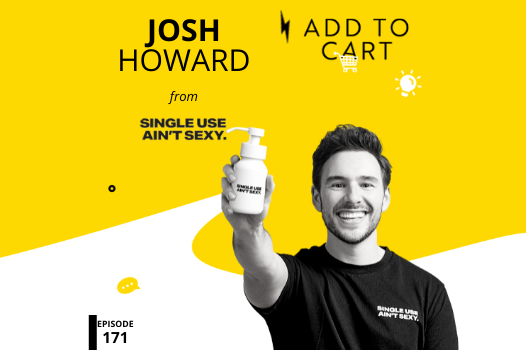In this episode of Add To Cart, we are joined by Josh Howard, Founder of Single Use Ain’t Sexy, yes that’s the brand name, Single Use Ain’t Sexy. He has come up with a unique product which is a massive hack to save time, save money and hopefully save the planet! He calls it the Berocca for hand soap – and it’s got nothing to do with consuming it when you’re hungover, I’ll leave him to explain. In this chat we cover so much ground. From how Single Use Ain’t Sexy’s impact is made not only by reducing over 100,000 plastic bottles from circulation, but also by removing water from the supply chain. We also discuss how it took 93 discussions with suppliers before he cracked the formula, how Josh raised their initial funding from their own supporters and why he thinks Australians are a bit sick of subscriptions!
“Time spent trying to personalise stuff can pay off immeasurably”
Josh Howard
Questions answered in this episode include…
- What are your tips for making a sustainable product successful?
- How is your fulfilment organised?
- How will you be expanding your range in the future?
The tablet revolution
“I was seeing waterless products be applicable to different categories, and I thought, “Why is no one doing this in the personal care vertical?” So if you think about this kind of concept, it’s not necessarily reinventing the wheel. It’s doing something that’s existed for years.
As a kid, my brother and I drank powdered cordial that you mix water with, or you go camping and you have powdered milk or powdered mashed potatoes, or my granddad had denture cleaning tablets. So it’s about finding new ways to expand something that’s been done, but do it in a way that I think I wasn’t really seeing.
Marrying up sustainability and beautiful design with a cheeky sense of humor is something that I think there’s a massive wide space for, this sense that you can look good and do good and you don’t have to compromise on having beautiful things just to be more eco-friendly.”
Personal survey hack
“ I love a good hack. My entire life and work is now figured out. What’s a shortcut? A more efficient way that we can get what we need? I hit up individual customers and say, “Hey, you bought soap from us a few months ago. We’re trying to grow our impact. I would love it if you could just give us two minutes of your time,”
Send them a link to a typeform that has 10 questions in it, never more than 10 questions ever; otherwise they don’t do it. Ask a whole bunch of questions where they always have to have a pre-written or selected options, never open-ended stuff because no one answers it properly. Then it all goes into an Excel doc and then I get my team to basically translate it into consumable data and present it in 10 slides, each one on 10 slides, then we make decisions.
It’s funny. You think you have to incentivize people all the time and “Hey, get 10% off to fill out this feedback.” If you just say “Hi, I’m an Aussie founder, I’m trying to make a difference. Can you just give me a hand? Two minutes of your time?” The uptake we had on those surveys was 65%. I know that it’s a bit of a pain in the ass to have to go one by one, but sometimes it’s a false economy to think otherwise, and I think time spent trying to personalize stuff can pay off immeasurably.”
Try before you subscribe
“I actually think people are a bit sick of subscriptions. I think the fact that it’s trending is almost worked against other subscription business at the moment, because people feel like how many bloody subscriptions can they actually have? And so the big lesson for me has been yeah, subscriptions suit us really well from a financial perspective and from an impact perspective, but what you actually want is you want people to try the product first and love it, and then get them to subscribe.
At the start, I think we were getting frustrated because we’re like “Oh, why aren’t more people getting a subscription up front?” And then I thought, “Well, hang on. I’m not buying subscriptions for stuff that I haven’t tried before. If I’m going to invest my hard earned children’s inheritance into products or anything, I want to make sure that it’s valuable and that it adds value to my life.”
So I think now we are much more conscious about trying to make people stick after that initial one time purchase. We’re still selling subscriptions up front, don’t get me wrong. But I think the longer term play and the smarter strategy is to let people try it first and then upsell them to a subscription.”
Links from the episode:
This episode was brought to you by…





